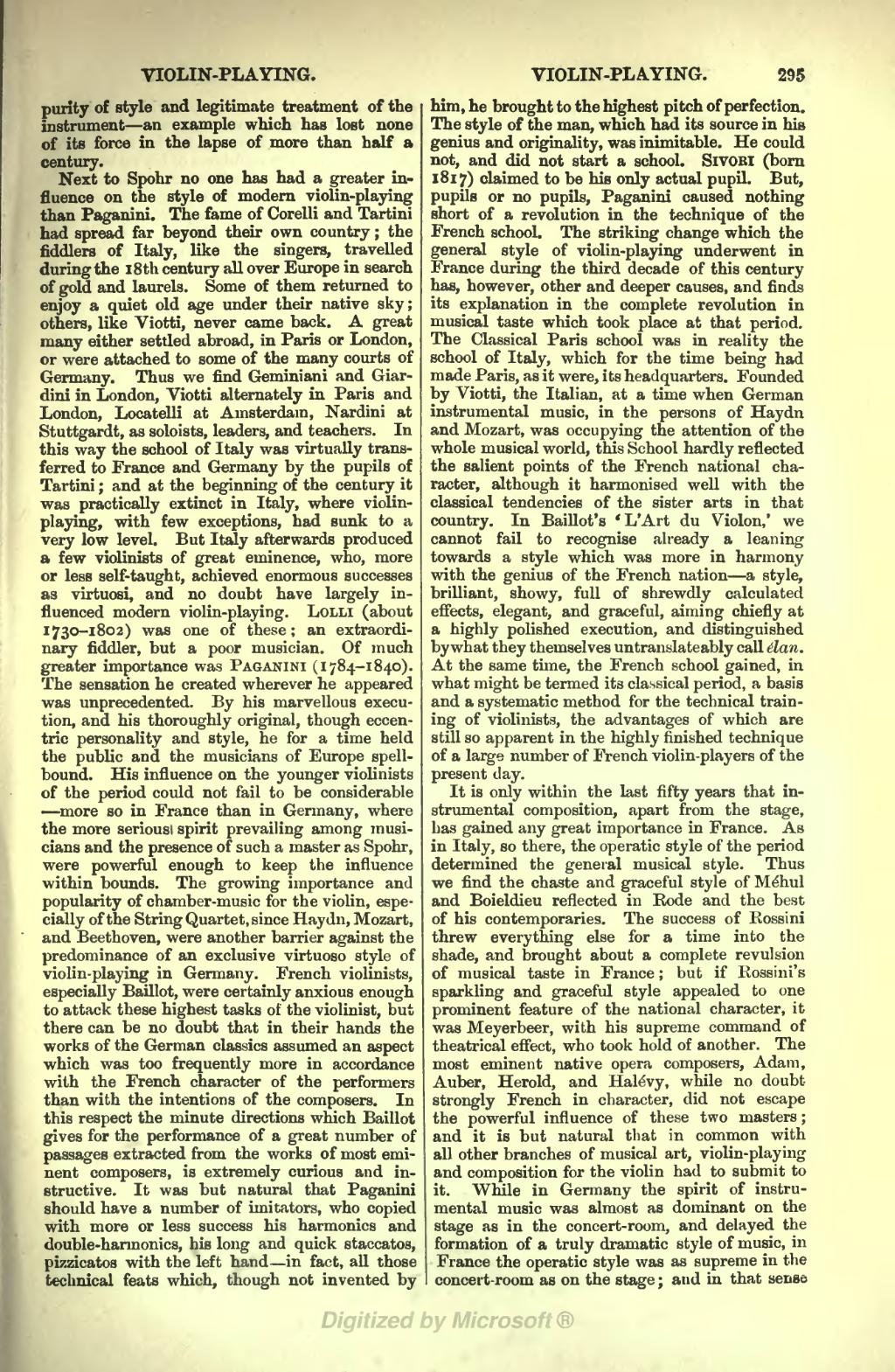purity of style and legitimate treatment of the instrument—an example which has lost none of its force in the lapse of more than half a century.
Next to Spohr no one has had a greater influence on the style of modern violin-playing than Paganini. The fame of Corelli and Tartini had spread far beyond their own country; the fiddlers of Italy, like the singers, travelled during the 18th century all over Europe in search of gold and laurels. Some of them returned to enjoy a quiet old age under their native sky; others, like Viotti, never came back. A great many either settled abroad, in Paris or London, or were attached to some of the many courts of Germany. Thus we find Geminiani and Giardini in London, Viotti alternately in Paris and London, Locatelli at Amsterdam, Nardini at Stuttgardt, as soloists, leaders, and teachers. In this way the school of Italy was virtually transferred to France and Germany by the pupils of Tartini; and at the beginning of the century it was practically extinct in Italy, where violin-playing, with few exceptions, had sunk to a very low level. But Italy afterwards produced a few violinists of great eminence, who, more or less self-taught, achieved enormous successes as virtuosi, and no doubt have largely influenced modern violin-playing. Lolli (about 1730–1802) was one of these; an extraordinary fiddler, but a poor musician. Of much greater importance was Paganini (1784–1840). The sensation he created wherever he appeared was unprecedented. By his marvellous execution, and his thoroughly original, though eccentric personality and style, he for a time held the public and the musicians of Europe spell-bound. His influence on the younger violinists of the period could not fail to be considerable—more so in France than in Germany, where the more serious spirit prevailing among musicians and the presence of such a master as Spohr, were powerful enough to keep the influence within bounds. The growing importance and popularity of chamber-music for the violin, especially of the String Quartet, since Haydn, Mozart, and Beethoven, were another barrier against the predominance of an exclusive virtuoso style of violin-playing in Germany. French violinists, especially Baillot, were certainly anxious enough to attack these highest tasks of the violinist, but there can be no doubt that in their hands the works of the German classics assumed an aspect which was too frequently more in accordance with the French character of the performers than with the intentions of the composers. In this respect the minute directions which Baillot gives for the performance of a great number of passages extracted from the works of most eminent composers, is extremely curious and instructive. It was but natural that Paganini should have a number of imitators, who copied with more or less success his harmonics and double-harmonics, his long and quick staccatos, pizzicatos with the left hand—in fact, all those technical feats which, though not invented by him, he brought to the highest pitch of perfection. The style of the man, which had its source in his genius and originality, was inimitable. He could not, and did not start a school. Sivori (born 1817) claimed to be his only actual pupil. But, pupils or no pupils, Paganini caused nothing short of a revolution in the technique of the French school. The striking change which the general style of violin-playing underwent in France during the third decade of this century has, however, other and deeper causes, and finds its explanation in the complete revolution in musical taste which took place at that period. The Classical Paris school was in reality the school of Italy, which for the time being had made Paris, as it were, its headquarters. Founded by Viotti, the Italian, at a time when German instrumental music, in the persons of Haydn and Mozart, was occupying the attention of the whole musical world, this School hardly reflected the salient points of the French national character, although it harmonised well with the classical tendencies of the sister arts in that country. In Baillot's 'L'Art du Violon,' we cannot fail to recognise already a leaning towards a style which was more in harmony with the genius of the French nation—a style, brilliant, showy, full of shrewdly calculated effects, elegant, and graceful, aiming chiefly at a highly polished execution, and distinguished by what they themselves untranslateably call élan. At the same time, the French school gained, in what might be termed its classical period, a basis and a systematic method for the technical training of violinists, the advantages of which are still so apparent in the highly finished technique of a large number of French violin-players of the present day.
It is only within the last fifty years that instrumental composition, apart from the stage, has gained any great importance in France. As in Italy, so there, the operatic style of the period determined the general musical style. Thus we find the chaste and graceful style of Méhul and Boieldieu reflected in Rode and the best of his contemporaries. The success of Rossini threw everything else for a time into the shade, and brought about a complete revulsion of musical taste in France; but if Rossini's sparkling and graceful style appealed to one prominent feature of the national character, it was Meyerbeer, with his supreme command of theatrical effect, who took hold of another. The most eminent native opera composers, Adam, Auber, Herold, and Halévy, while no doubt-strongly French in character, did not escape the powerful influence of these two masters; and it is but natural that in common with all other branches of musical art, violin-playing and composition for the violin had to submit to it. While in Germany the spirit of instrumental music was almost as dominant on the stage as in the concert-room, and delayed the formation of a truly dramatic style of music, in France the operatic style was as supreme in the concert-room as on the stage; and in that sense

